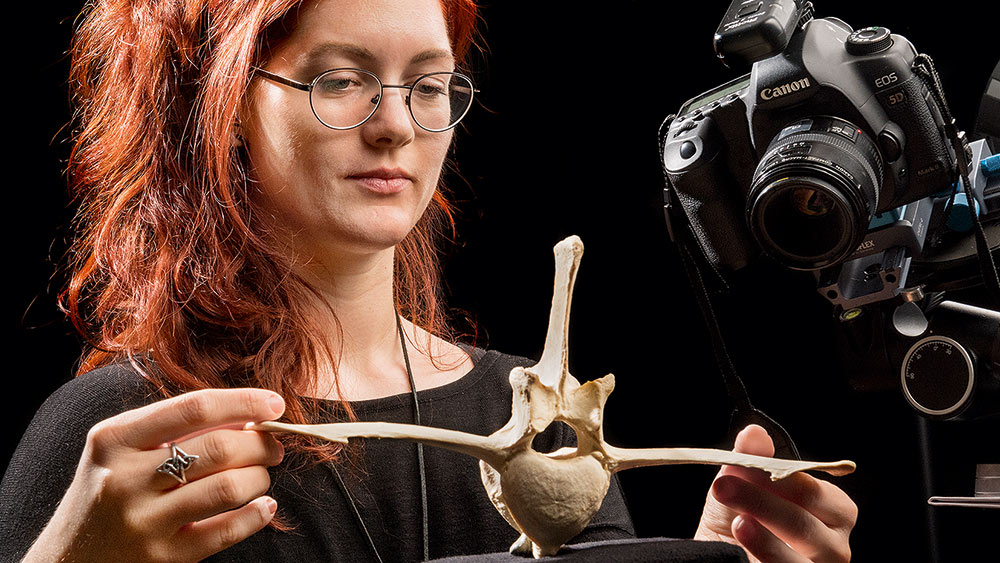Navigation auf uzh.ch
Navigation auf uzh.ch

Emigrate to Cairo and pursue photography projects: That was Michelle Aimée Oesch’s initial plan when she took on a temporary job as scientific photographer at UZH after completing her studies. But instead of going out to discover the big wide world, she instead found herself engrossed in the microscopic world of parasites, worms, bones, and embryos. The employee whom Oesch was temporarily replacing left – and Oesch stayed. Instead of emigrating, she made do with a three-month trip to Egypt before permanently taking up her position in the Communications team at the Veterinary Teaching Hospital.
That was five years ago, and Oesch is still happy with her choice. “The work is enormously varied, and I can organize my time as I wish – a real dream job.” In addition to clinical photography, her work includes portraits of employees and pictures of animals, rooms, equipment, drugs, and 3-D models. Sometimes she also takes pictures to accompany instructions in text books – for example a vet demonstrating how to fix a bird’s broken wing. She takes the pictures either in her fully equipped studio in the hospital, or in the dissection lab. For portraits, she has found an ideal location in the small animal clinic.
Oesch always knew that she didn’t just want to do photography as a hobby, but wanted to make it her profession. After school she studied photography at Zurich University of the Arts (ZHdK). The course included an exchange year in Melbourne. That wasn’t the first time that Oesch had lived abroad: She spent the first five years of her life in the USA (her mother is American). She has also traveled widely in other parts of the world, including extended stays in Egypt, where she pursued photographic projects. She will soon complete a two-year Master’s degree: Alongside her work at UZH, she will study visual communications and picture research at the University of Applied Sciences of North West Switzerland.
Oesch has striking long red hair – but often her hair is the only colorful thing about her, as she normally dresses in black from head to toe, sometimes branching out into other neutral colors. This is partly for professional reasons – vibrant colors can create shadows in the studio. But also, she admits, she finds it hard to put the right colors together. “On top of that, I don’t like to be the center of attention. That’s why I tend to wear unobtrusive colors.”
What Oesch likes about doing clinical photography is that she is providing practical problem-solving help to people but can also use her own creative style. “A good photo must both meet the purpose and be aesthetically pleasing.” She composes her photographs in a very clean style under natural light often using a black background, which intensifies the effect of the objects. “For this type of work you have to be very flexible, prepared to compromise, and solution-oriented,” she explains, adding: “Being a bit of a perfectionist certainly helps too.” One thing she’d still like to do at UZH is to meet the other photographers employed by the University to exchange experiences about their work and to support each other.
Oesch pulls the lumbar vertebrae of a horse out of a cupboard behind her. “When shooting portraits I sometimes feel I’m not doing justice to the subject. But with objects, I find it easier to focus on the essential.” That’s why she doesn’t think wedding or baby photography would suit her, she says. She explained this in a newspaper interview, saying: “I’m too introverted to make others feel comfortable in front of the camera.”
Oesch did once make a brief foray into fashion photography. But she disliked the ephemeral nature of the industry, and she also had ethical qualms: “The fashion industry often tries to make people feel inferior so that they buy things that they don’t really need just in order to feel happy.”
Her work at UZH has also influenced Michelle Aimée Oesch’s own private photography work. For example, for a series of photographs she displayed at the Photo17 exhibition, she shone the spotlight on dogs’ and cats’ paws. In another private project, Oesch took a series of photographs with four views of a giraffe’s vertebra. The different angles of each of the views meant they looked like completely different bones.
Oesch even recently bought a pig destined for the slaughterhouse for a long-term project. She doesn’t want to give away any details, as the project is still in its infancy. But she does drop a hint: The motivation behind the project is her disgust at the meat industry and the lack of decent conditions for livestock, “especially in relation to the completely under-appreciated domestic pig.”
And what about Cairo? She still has projects she wants to finish there – she will definitely go back one day, affirms Michelle Aimée Oesch. Then she carefully puts the horse’s lumbar vertebrae back in the cupboard and returns to her work.